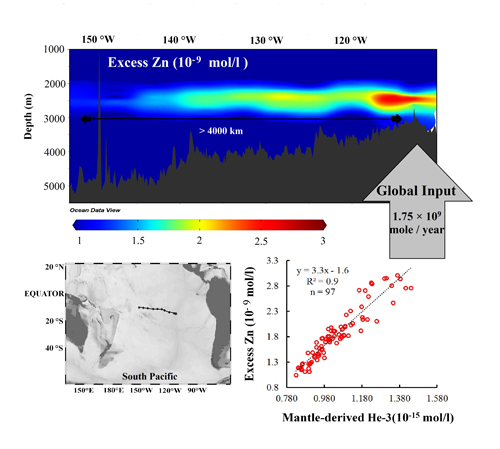Hydrothermalism: a major contributor to the oceanic inventory of dissolved zinc
High-quality dataset of dissolved zinc (Zn) from the US GEOTRACES EPZT cruise (GP16 section) allows Roshan and co-workers (2016, see reference below) to revisit the oceanic budget of dissolved Zn. These investigators have observed a basin-scale transport of mantle-derived dissolved Zn from the hydrothermal vents of the East Pacific Rise to the farfield regions (>4000 km away) across the South Pacific at depths 2300–2800 m (see Figure). The strong correlation (R2 = 0.9) between hydrothermal-controlled component of dissolved Zn (i.e. Excess Zn) and hydrothermal activity tracer, 3He leads to a global hydrothermal zinc flux of 1.75 ± 0.35 G mol yr− 1 that is many-fold higher than the input fluxes estimated by other studies. These results suggest that mantle-derived dissolved Zn dominates the oceanic Zn inventory and that dissolved Zn residence time is much shorter (3000 ± 600 years) than previous input-based estimates (11,000 and 50,000 years) and more consistent with previous removal-based estimate (3000–6000 years)…

Reference:
Roshan, S., Wu, J., & Jenkins, W. J. (2016). Long-range transport of hydrothermal dissolved Zn in the tropical South Pacific. Marine Chemistry, 183, 25–32. doi:10.1016/j.marchem.2016.05.005
